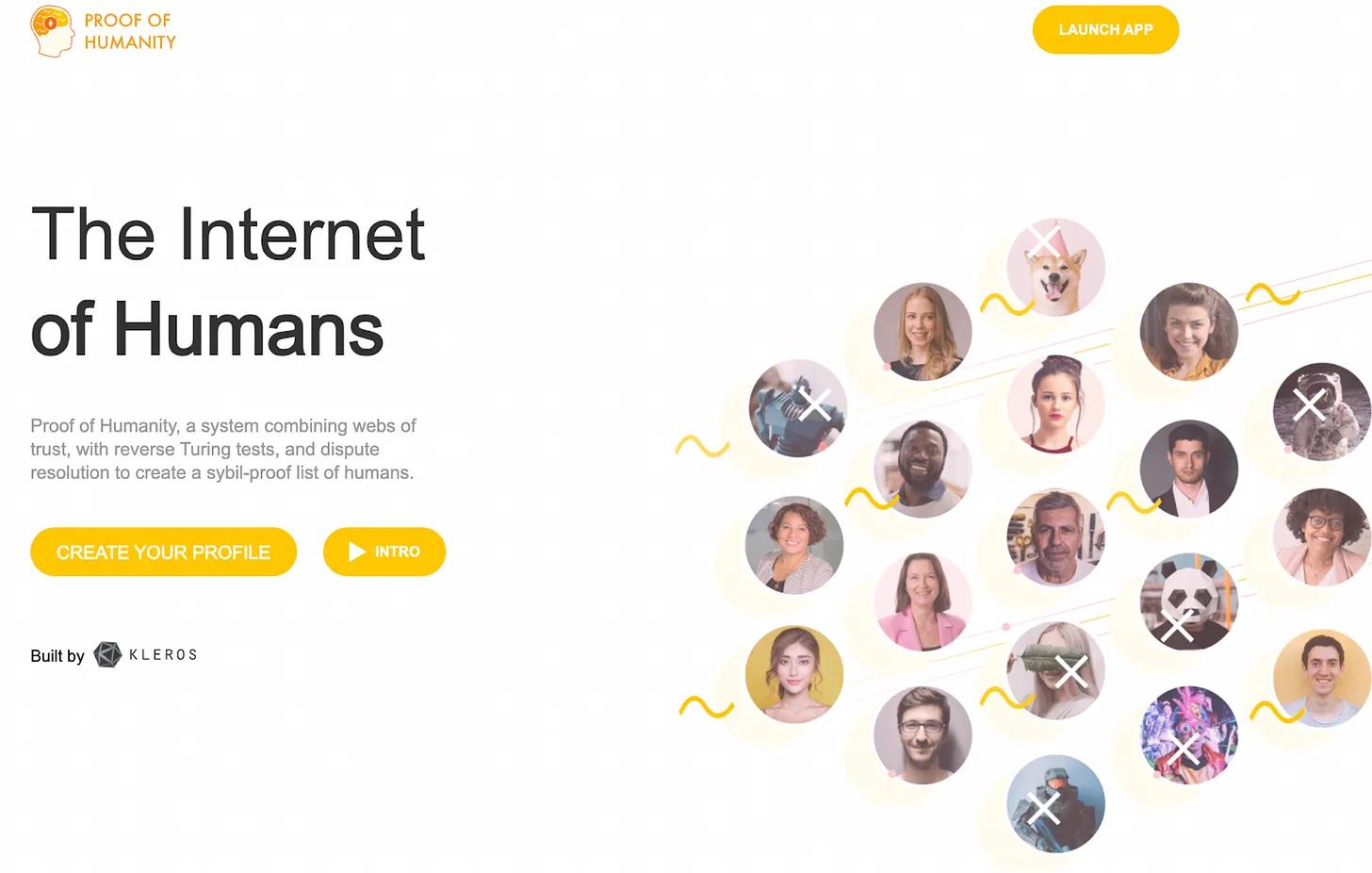Exploring the Future of Web3 Social (Part 2) Solving User Identity Issues with Proof-of-Personhood and Cryptographic Techniques
Web3 Social Future (Part 2) Solving User Identity Issues with Proof-of-Personhood and Cryptographic TechniquesAuthor: LianGuaiUL VERADITTAKIT, Partner at LianGuaintera
Translation: Deep Tide TechFlow
This article is the second in a series of decentralized social articles written by LianGuaiUL, a partner at LianGuaintera.
This series explores how current technologies and trends address a range of issues in decentralized social networks, providing specific explanations and explorations for each problem.
- The Engine Driving the Bitcoin Bull Market Grayscale Lawsuit, Ethereum Futures ETF, and Bitcoin Spot ETF.
- Bankless Podcast Selection Exploring the SET Evaluation Framework for Blockchain Systems Which is More Important, the Technical Layer, the Ecological Layer, or the Social Layer?
- Disassembling Rollup Economics Business Models, Interoperability, and Layer 3
Previous article: “Exploring the Future of Web3 Social (Part 1): From 0 to 1, Cold-starting Applications with Social Graphs”
In 2017, a group of researchers from the MIT Media Lab claimed in Wired magazine that decentralized social networks would “never succeed.” In their article, they listed three impossible challenges:
- The problem of attracting (and retaining) users from scratch
- The problem of handling users’ personal information
- The problem of user-oriented advertising
They believed that in all three cases, existing tech giants such as Facebook, Twitter, and Google, due to their extensive economies of scale, left no room for any significant competition.
Now, what was once considered “impossible” seems less distant. We seem to be at the dawn of a conceptual shift in social media networks. In this three-part series (this being Part 2), we will explore how new ideas in decentralized social (DeSo) address these “ancient” problems, including:
- Using an open social layer to solve the cold-start problem
- Using proof of personhood and cryptographic technology to solve the user identity problem
- Using token economics models and incentive mechanisms to solve the revenue problem
In this article, the author primarily discusses the solution to problem 2.
The User Identity Problem in Social Media
Modern social media faces the issue of bots. While social media platforms have an obligation to uphold freedom of speech, it becomes tricky when the “users” involved are actually bots.
It turns out that bots have had a significant impact on public discourse, from being accused of interfering with the US presidential election to influencing public perceptions of COVID. Especially in contexts that emphasize anonymity, security, and privacy, any decentralized social media platform inherits the “bot problem” – that is, in the era of advanced artificial intelligence, how do you convince people that the accounts on your platform are real and not bots?
One naive approach is to adopt traditional KYC protocols, but this approach immediately encounters privacy issues – the other side of the problem. Why should you trust any social media platform to store our sensitive data (from government IDs to private messages and financial transactions) that could reconstruct an individual’s entire personal, social, and professional life?
Therefore, the “user identity” problem is essentially a tension between confirming that users are “indeed human” and ensuring privacy guarantees for personal data. In this article, we will explore two different approaches to solving this problem: one using biometric methods (using zero-knowledge proofs) and the other using social guarantees.
Worldcoin and Biometric Authentication
In the field of “proof of personhood,” Worldcoin is one of the most famous and controversial projects. In addition to having OpenAI CEO Sam Altman as one of its supporters, Worldcoin’s solution to the “proof of personhood” problem is very straightforward: it uses retinal scanning to create biometric proof that you are a human (since robots don’t have retinas) and obtain an authentication token from it. As for data privacy, Worldcoin claims to use zero-knowledge proofs to ensure that the acquired biometric data is securely stored.

The argument of Worldcoin is that as artificial intelligence plays an increasingly important role in society, it is necessary to differentiate between humans and robots in a way that protects privacy and is decentralized. By using the retinal scanning of the Worldcoin sphere, people can obtain a World ID similar to a “digital passport,” which makes it possible for the holder to qualify for a global basic income mechanism based on cryptocurrency and participate in new mechanisms of global democratic governance. Essentially, this World ID is intended to be the social primitive mechanism of future digital social networks.
In its documentation, Worldcoin emphasizes its privacy-first solution. For example, it states that it deletes the images collected by the sphere and only stores the hash of the user’s iris, and runs zero-knowledge proofs (zk-SNARKs) to share proof of personhood information without disclosing any personal data. Although in the current launch phase, these hash values are stored in a centralized database, the team is committed to storing these iris hash data on the blockchain once the hash algorithm is fully mature.
However, despite these privacy protection claims, there are still many controversies regarding real privacy, security, and fair guarantees. For example, some claim that the credentials of Worldcoin operators have been stolen, and World IDs are being sold on the digital black market so that users can obtain Worldcoin tokens without undergoing retinal scanning. There are also overall fairness issues, with MIT Technology Review publishing a sharp article in April 2022 accusing Worldcoin of deceiving, manipulating, and exploiting nearly 500,000 users (mainly users in developing countries) during the testing phase, even calling it a form of “cryptocolonialism.” In fact, as of August 2, 2023, Kenya, which was once one of the largest data collection sites for Worldcoin, has banned Worldcoin scanning due to security, privacy, and financial concerns.
In addition to these project-specific controversies, there are also broader concerns about the overall adoption of dedicated hardware for biometric authentication by Worldcoin. Because the sphere is essentially a hardware device, even if Worldcoin’s software is flawless, there is no guarantee that there are no hardware backdoors that allow Worldcoin (or other third-party manufacturers) to secretly collect users’ actual biometric data or insert false personal profiles into the system. For skeptics, all of Worldcoin’s privacy guarantees (zero-knowledge proofs, iris hash, on-chain decentralization) seem to be a kind of irony.
Proof of Humanity and Social Guarantee
Another way to solve the problem of personal identity verification is to use the method of social guarantee. Essentially, if verified humans Alice, Bob, Charlie, and David all “guarantee” that Emily is a verified human, then Emily is likely to be a human as well. The core issue here is therefore a game theory design problem – how do we design incentive mechanisms to “verify humans” to the greatest extent possible.

Proof of human identity is one of the oldest and most important projects in this field. To “prove your human identity”, you need to:
- Submit personal information, photos, videos, and a deposit of 0.125 ETH,
- Have humans who are already in the registry vouch for you,
- Pass before the “3 challenge periods”. If someone challenges you during this period, the case will be submitted to the decentralized court Kleros, and the deposit will be at risk.
In the proof process, users are first paired with an attester through a credential form. After being paired with an attester, they will have a video call to verify the matching of personal information and real person. Similar to the Worldcoin paper, the proof of human identity community has long had an idea of a universal basic income (UBI) that will be provided to individuals verified in the human identity registry.
Other projects are also on a similar path, using social graphs to verify human identities, including BrightID’s video call verification, where everyone verifies each other, Idena’s ongoing captcha creation and solving, and Circles’ trust-based circles.
The biggest appeal of these social verification-based platforms may be that they don’t seem as invasive as Worldcoin, which requires you to scan your iris on a metal sphere. Some of these methods, such as Idena’s captcha “checkpoint ritual”, even seem to retain a certain degree of anonymity, without requiring a large amount of personal data sharing or third-party identity authentication centers.
The Future of Human Identity
With the continuous advancement of artificial intelligence and the demonstration of more and more characteristics that resemble human behavior, designing novel mechanisms for proving human identity has become increasingly important, not only for the incentive measures discussed in universal basic income and many other human identity proof projects, but also as a way to better purify and regulate future social networks.
However, from data privacy to the invasiveness of processes, to determining the validity of human identity, this process involves many trade-offs and is one of the famous “challenges in cryptocurrency”. As Vitalik pointed out, there doesn’t seem to be an ideal form of human identity proof, and he proposed a possible hybrid path as a suggestion: a biometrics-based starting method, but transitioning to more social graph-based methods in the long term.

In looking ahead to the future, this field requires more transparency in processes, code, and data. In short, there can be no ironic paradox where users need to “trust that this is a trustless solution.” Only through this approach can we truly create a social networking foundation that aligns with the original decentralized and privacy-focused vision of cryptocurrencies.
We will continue to update Blocking; if you have any questions or suggestions, please contact us!
Was this article helpful?
93 out of 132 found this helpful
Related articles
- Opinion The market’s focus is no longer simply on proving the superiority or inferiority of technology.
- LD Capital Puffer – Secure Signer technology empowerment, LSD track dark horse
- Key Factors for CHEX’s Success Mobile Native Embedded Technology Improving Trading Experience
- W Labs Why are all Web3 models Ponzi schemes?
- Vitalik on AI Will not replace humans, we will eventually adapt to the new technological wave
- Can you make payments by talking to AI? The Reserve Bank of India explores innovative instant payment technology.
- Glassnode Cryptocurrency market trading volume reaches historical low, BTC is experiencing an unprecedented period of low volatility
